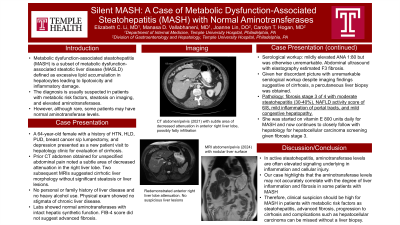Sunday Poster Session
Category: Liver
P1429 - Silent MASH: A Case of Metabolic Dysfunction-Associated Steatohepatitis (MASH) with Normal Aminotransferases
Sunday, October 27, 2024
3:30 PM - 7:00 PM ET
Location: Exhibit Hall E

Has Audio

Elizabeth Li, MD
Temple University Hospital
Philadelphia, PA
Presenting Author(s)
Elizabeth Li, MD1, Manasa Vallabhaneni, MD1, Joanne Lin, DO2, Carolyn Hogan, MD1
1Temple University Hospital, Philadelphia, PA; 2Temple University, Philadelphia, PA
Introduction: Metabolic dysfunction-associated steatohepatitis (MASH) is a subset of metabolic dysfunction-associated steatotic liver disease (MASLD) defined as excessive lipid accumulation in hepatocytes leading to lipotoxicity and inflammatory damage. The diagnosis is usually suspected in patients with metabolic risk factors, steatosis on imaging, and elevated aminotransferases. However, although rare, some patients may have normal aminotransferase levels.
Case Description/Methods: A 64-year-old female with a history of hypertension, hyperlipidemia, peptic ulcer disease, breast cancer s/p lumpectomy, and depression presented as a new patient visit to hepatology clinic for evaluation of cirrhosis. She had a prior CT abdomen obtained for unspecified abdominal pain, which noted a subtle area of decreased attenuation in the right liver lobe. Two subsequent MRIs suggested cirrhotic liver morphology without significant steatosis or liver lesions. She denied a personal or family history of liver disease and did not endorse heavy alcohol use. Physical exam showed no stigmata of chronic liver disease. All of her laboratory studies showed normal aminotransferases with intact hepatic synthetic function. FIB-4 score did not suggest advanced fibrosis. Serological workup was notable for a mildly elevated ANA 1:80, but was otherwise unremarkable. Abdominal ultrasound with elastography estimated F3 fibrosis.
Given her discordant picture with unremarkable serological workup despite imaging findings suggestive of cirrhosis, a percutaneous liver biopsy was obtained. This showed fibrosis stage 3 of 4 with moderate steatohepatitis (30-40%), NAFLD activity score of 6/8, mild inflammation of portal tracts, and mild congestive hepatopathy. She was started on vitamin E 800 units daily for MASH and now continues to closely follow with hepatology for hepatocellular carcinoma screening given fibrosis stage 3.
Discussion: In active steatohepatitis, aminotransferase levels are often elevated signaling underlying in inflammation and cellular injury. Our case highlights that the aminotransferase levels may not accurately correlate with the degree of liver inflammation and fibrosis in some patients with MASH. Therefore, clinical suspicion should be high for MASH in patients with metabolic risk factors as steatohepatitis, advanced fibrosis, progression to cirrhosis and complications such as hepatocellular carcinoma can be missed without a liver biopsy.
Disclosures:
Elizabeth Li, MD1, Manasa Vallabhaneni, MD1, Joanne Lin, DO2, Carolyn Hogan, MD1. P1429 - Silent MASH: A Case of Metabolic Dysfunction-Associated Steatohepatitis (MASH) with Normal Aminotransferases, ACG 2024 Annual Scientific Meeting Abstracts. Philadelphia, PA: American College of Gastroenterology.
1Temple University Hospital, Philadelphia, PA; 2Temple University, Philadelphia, PA
Introduction: Metabolic dysfunction-associated steatohepatitis (MASH) is a subset of metabolic dysfunction-associated steatotic liver disease (MASLD) defined as excessive lipid accumulation in hepatocytes leading to lipotoxicity and inflammatory damage. The diagnosis is usually suspected in patients with metabolic risk factors, steatosis on imaging, and elevated aminotransferases. However, although rare, some patients may have normal aminotransferase levels.
Case Description/Methods: A 64-year-old female with a history of hypertension, hyperlipidemia, peptic ulcer disease, breast cancer s/p lumpectomy, and depression presented as a new patient visit to hepatology clinic for evaluation of cirrhosis. She had a prior CT abdomen obtained for unspecified abdominal pain, which noted a subtle area of decreased attenuation in the right liver lobe. Two subsequent MRIs suggested cirrhotic liver morphology without significant steatosis or liver lesions. She denied a personal or family history of liver disease and did not endorse heavy alcohol use. Physical exam showed no stigmata of chronic liver disease. All of her laboratory studies showed normal aminotransferases with intact hepatic synthetic function. FIB-4 score did not suggest advanced fibrosis. Serological workup was notable for a mildly elevated ANA 1:80, but was otherwise unremarkable. Abdominal ultrasound with elastography estimated F3 fibrosis.
Given her discordant picture with unremarkable serological workup despite imaging findings suggestive of cirrhosis, a percutaneous liver biopsy was obtained. This showed fibrosis stage 3 of 4 with moderate steatohepatitis (30-40%), NAFLD activity score of 6/8, mild inflammation of portal tracts, and mild congestive hepatopathy. She was started on vitamin E 800 units daily for MASH and now continues to closely follow with hepatology for hepatocellular carcinoma screening given fibrosis stage 3.
Discussion: In active steatohepatitis, aminotransferase levels are often elevated signaling underlying in inflammation and cellular injury. Our case highlights that the aminotransferase levels may not accurately correlate with the degree of liver inflammation and fibrosis in some patients with MASH. Therefore, clinical suspicion should be high for MASH in patients with metabolic risk factors as steatohepatitis, advanced fibrosis, progression to cirrhosis and complications such as hepatocellular carcinoma can be missed without a liver biopsy.
Disclosures:
Elizabeth Li indicated no relevant financial relationships.
Manasa Vallabhaneni indicated no relevant financial relationships.
Joanne Lin indicated no relevant financial relationships.
Carolyn Hogan indicated no relevant financial relationships.
Elizabeth Li, MD1, Manasa Vallabhaneni, MD1, Joanne Lin, DO2, Carolyn Hogan, MD1. P1429 - Silent MASH: A Case of Metabolic Dysfunction-Associated Steatohepatitis (MASH) with Normal Aminotransferases, ACG 2024 Annual Scientific Meeting Abstracts. Philadelphia, PA: American College of Gastroenterology.
